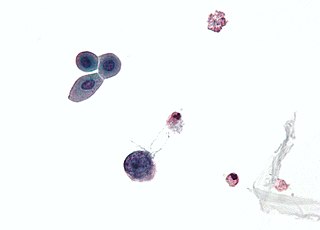
Tacrolimus, sold under the brand name Prograf among others, is an immunosuppressive drug. After allogenic organ transplant, the risk of organ rejection is moderate. To lower the risk of organ rejection, tacrolimus is given. The drug can also be sold as a topical medication in the treatment of T-cell-mediated diseases such as eczema and psoriasis. For example, it is prescribed for severe refractory uveitis after a bone marrow transplant, exacerbations of minimal change disease, Kimura's disease, and vitiligo. It can be used to treat dry eye syndrome in cats and dogs.

Immunosuppression is a reduction of the activation or efficacy of the immune system. Some portions of the immune system itself have immunosuppressive effects on other parts of the immune system, and immunosuppression may occur as an adverse reaction to treatment of other conditions.

Immunosuppressive drugs, also known as immunosuppressive agents, immunosuppressants and antirejection medications, are drugs that inhibit or prevent the activity of the immune system.

A pancreas transplant is an organ transplant that involves implanting a healthy pancreas into a person who usually has diabetes.

Azathioprine, sold under the brand name Imuran, among others, is an immunosuppressive medication. It is used for the treatment of rheumatoid arthritis, granulomatosis with polyangiitis, Crohn's disease, ulcerative colitis, and systemic lupus erythematosus; and in kidney transplants to prevent rejection. It is listed by the International Agency for Research on Cancer as a group 1 human carcinogen. It is taken by mouth or injected into a vein.
Basiliximab, sold under the brand name Simulect, is a monoclonal antibody used to prevent rejection in kidney transplants. It is a chimeric mouse-human monoclonal antibody to the α chain (CD25) of the IL-2 receptor of T cells. It is used in combination with other medicines used to prevent organ rejection.

Leukopenia is a decrease in the number of leukocytes (WBC). Found in the blood, they are the white blood cells, and are the body's primary defense against an infection. Thus the condition of leukopenia places individuals at increased risk of infection.

Lupus nephritis is an inflammation of the kidneys caused by systemic lupus erythematosus (SLE), an autoimmune disease. It is a type of glomerulonephritis in which the glomeruli become inflamed. Since it is a result of SLE, this type of glomerulonephritis is said to be secondary, and has a different pattern and outcome from conditions with a primary cause originating in the kidney. The diagnosis of lupus nephritis depends on blood tests, urinalysis, X-rays, ultrasound scans of the kidneys, and a kidney biopsy. On urinalysis, a nephritic picture is found and red blood cell casts, red blood cells and proteinuria is found.

Cyclophosphamide (CP), also known as cytophosphane among other names, is a medication used as chemotherapy and to suppress the immune system. As chemotherapy it is used to treat lymphoma, multiple myeloma, leukemia, ovarian cancer, breast cancer, small cell lung cancer, neuroblastoma, and sarcoma. As an immune suppressor it is used in nephrotic syndrome, granulomatosis with polyangiitis, and following organ transplant, among other conditions. It is taken by mouth or injection into a vein.

The BK virus, also known as Human polyomavirus 1, is a member of the polyomavirus family. Past infection with the BK virus is widespread, but significant consequences of infection are uncommon, with the exception of the immunocompromised and the immunosuppressed. BK virus is an abbreviation of the name of the first patient, from whom the virus was isolated in 1971.
Synergistic enhancers of antiretrovirals usually do not possess any antiretroviral properties alone, but when they are taken concurrently with antiretroviral drugs they enhance the effect of that drug.
Purine metabolism refers to the metabolic pathways to synthesize and break down purines that are present in many organisms.

Inosine-5′-monophosphate dehydrogenase (IMPDH) is a purine biosynthetic enzyme that catalyzes the nicotinamide adenine dinucleotide (NAD+)-dependent oxidation of inosine monophosphate (IMP) to xanthosine monophosphate (XMP), the first committed and rate-limiting step towards the de novo biosynthesis of guanine nucleotides from IMP. IMPDH is a regulator of the intracellular guanine nucleotide pool, and is therefore important for DNA and RNA synthesis, signal transduction, energy transfer, glycoprotein synthesis, as well as other process that are involved in cellular proliferation.

Mizoribine is an immunosuppressive drug. The compound was first observed in Tokyo, Japan, in 1971. First isolated from the fungus Penicillium brefeldianum. Mizoribine (MZB) is an imidazole nucleoside that has been used in renal transplantation, and in steroid-resistant nephrotic syndrome, IgA nephropathy, lupus, as well as for adults with rheumatoid arthritis, lupus nephritis and other rheumatic diseases. MZB exerts its activity through selective inhibition of inosine monophosphate dehydrogenase and guanosine monophosphate synthetase, resulting in the complete inhibition of guanine nucleotide synthesis without incorporation into nucleotides. It arrests DNA synthesis in the S phase of cellular division. Thus, MZB has less toxicity than azathioprine, another immunosuppressant used for some of the same diseases.
Diffuse proliferative glomerulonephritis (DPGN) is a type of glomerulonephritis that is the most serious form of renal lesions in SLE and is also the most common, occurring in 35% to 60% of patients. In absence of SLE, DPGN pathology looks more like Membranoproliferative glomerulonephritis

Inosine-5'-monophosphate dehydrogenase 2, also known as IMP dehydrogenase 2, is an enzyme that in humans is encoded by the IMPDH2 gene.

Voclosporin, sold under the brand name Lupkynis, is a calcineurin inhibitor used as an immunosuppressant medication for the treatment of lupus nephritis. It is an analog of ciclosporin that has enhanced action against calcineurin and greater metabolic stability.
The enzyme mycophenolic acid acyl-glucuronide esterase (EC 3.1.1.93, mycophenolic acid acyl-glucuronide deglucuronidase; AcMPAG deglucuronidase; systematic name mycophenolic acid O-acyl-glucuronide-ester hydrolase), is in humans encoded by the ABHD10 gene, and catalyses the reaction
Anthony Clifford Allison was a South African geneticist and medical scientist who made pioneering studies on the genetic resistance to malaria. Clark completed his primary schooling in Kenya, completed his higher education in South Africa, and obtained a BSc in medical science from the University of the Witwatersrand in 1947. He earned his PhD from the University of Oxford in 1950. After working at the Radcliffe Infirmary for two years, he worked as post-doctoral student to Linus Pauling in 1954. After teaching medicine for three years at Oxford, he worked at the Medical Research Council in London. In 1978 he simultaneously worked at the International Laboratory for Research on Animal Diseases (ILRAD) as its Director, and at the World Health Organization's (WHO) Immunology Laboratory, both in Nairobi. He later became the Vice President for Research at Syntex Corporation (1981-1994).

Bartolomeo Gosio was an Italian medical scientist. He discovered a toxic fume, eponymously named "Gosio gas", which is produced by microorganisms, that killed many people. He identified the chemical nature of the gas as an arsenic compound (arsine), but incorrectly named it as diethylarsine. He also discovered an antibacterial compound called mycophenolic acid from the mould Penicillium brevicompactum. He demonstrated that the novel compound was effective against the deadly anthrax bacterium, Bacillus anthracis. This was the first antibiotic compound isolated in pure and crystallised form. Though the original compound was abandoned in clinical practice due to its adverse effects, its chemical derivative mycophenolate mofetil became the drug of choice as an immunosuppressant in kidney, heart, and liver transplantations.
















